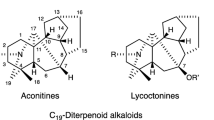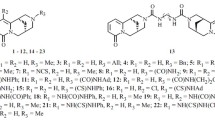Summary
Verapamil, a calcium channel blocker, is used as the racemate. Recently, racemic verapamil has been shown to increase the cytotoxicity of vinca alkaloid and anthracycline derivatives in several resistant tumour cell lines. With respect to its cardiovascular activity S-verapamil is an order of magnitude more potent than R-verapamil. Since it was not known whether the effect on multidrug resistance was also enantioselective a comparison has been made of the potency of the R and S enantiomers and racemic verapamil in their ability to increase the cytotoxicity of vincristine and daunomycin in sensitive (MOLT 4B) and drug resistant human T-lymphoma cell lines (MOLT/VCR-5×9, MOLT/DAU-8 and VCR 1000, a highly resistant subline of CCRF-CEM). Two major metabolites, norverapamil and D617 were tested in the same system.
(+)-R, (−)-S-, racemic verapamil, norverapamil and D617 alone had no effect on cell growth in sensitive or resistant cell lines in concentrations up to 20 μM. In combination with vincristine, verapamil and norverapamil but not D617 produced a concentration dependent increase in the sensitivity of the resistant lines. Racemic verapamil, its individual enantiomers and norverapamil were equipotent. The concentration of the modifiers required to elicit 50% of the maximum effect (EC50) was of the order of 0.5 μM. No significant difference in the slopes of the concentration-effect curves were observed. The effect of verapamil and norverapamil was additive. In the sensitive MOLT 4B cell line both enantiomers and norverapamil increased sensitivity towards vincristine. However, the EC50 values were at least an order of magnitude higher (2.5–8 μM) than in the resistant cell lines. In contrast to the vincristine resistant cell lines, no effect on the potentiation of daunomycin cytotoxicity was observed in sensitive and daunomycin-resistant cells in the presence of a modifier. Since the activity of verapamil as a modifier of drug resistance is not enantioselective, the weaker calcium antagonist R-enantiomer appears to be better suited for clinical trials. Because of its lesser cardiovascular activity much higher doses could be given, and a higher plasma concentration would be achieved. As norverapamil, the major plasma metabolite formed during first pass elimination, is as potent as the parent drug as a modifier of drug resistance, the oral route of administration is preferable to i. v. administration in clinical trials employing R-verapamil as a modifier.
Similar content being viewed by others
References
Benson III AB, Trump DL, Koeller JM, Egorin MI, Olman EA, Witte RS, Davis TE, Tormey DC (1985) Phase I study of vinblastine and verapamil given by concurrent iv infusion. Cancer Treat Rep 69: 795–799
Bradford MM (1976) A rapid and sensitive method for the quantification of microgram quantities of protein utilizing the principle of protein-dye binding. Anal Biochem 72: 248–254
Cairo MS, Siegel S, Anas N, Sender L (1989) Clinical trial of continuous infusion verapamil, bolus vinblastine, and continuous infusion VP-16 in drug-resistant pediatric tumors. Cancer Res 49: 1063–1066
Chang BK, Brenner DE, Gutman R (1989) Dissociation of the verapamil-induced enhancement of doxorubicin's cytotoxicity from changes in cellular accumulation or retention of doxorubicin in pancreatic cancer cell lines. Anticancer Res 9: 347–352
Chen C, Chin JE, Ueda K, Clark DP, Pastan I, Gottesman MM, Roninson IB (1986) Internal duplication and homology with bacterial transport proteins in the mdr1 (P-glycoprotein) gene from multidrug-resistant human cells. Cell 47: 381–389
Chirgwin JM, Przybyla AE, MacDonald RJ, Rutter WJ (1979) Isolation of biologically active ribonucleic acid from sources enriched in ribonuclease. Biochemistry 18: 5294–5299
Curtis MJ, Walker MJA (1986) The mechanism of action of the optical enantiomers of verapamil against ischaemia-induced arrythmias in the conscious rat. Br J Pharmacol 89: 137–147
Danø K (1976) Experimentally developed cellular resistance to daunomycin. Acta Pathol Microbiol Scand [A] 256: 11–80
Echizen H, Brecht T, Niedergesaess S, Vogelgesang B, Eichelbaum M (1985a) The effect of dextro-, levo-, and racemic verapamil on atrioventricular conduction in humans. Am J Heart 109: 210–217
Echizen H, Vogelgesang B, Eichelbaum M (1985b) The effect of D, L-verapamil on atrioventricular conduction in relation to its stereoselective first pass metabolism. Clin Pharmacol Ther 38: 71–76
Echizen H, Manz M, Eichelbaum M (1988) Electrophysiologic effects of dextro- and levo-verapamil on sinus node and AV node function in humans. J Cardiovasc Pharm 12: 543–546
Eichelbaum M (1988) Enantioselective drug metabolism and its pharmacokinetic and pharmacodynamics consequences. In: Gorrod JW, Oelschläger H, Caldwell J (eds) Metabolism of xenobiotics. Taylor and Francis, London
Endicott JA, Ling V (1989) The biochemistry of P-glycoprotein-mediated multidrug resistance. Annu Rev Biochem 58: 137–171
Fairbanks G, Steck TL, Wallach DFH (1971) Electrophoretic analysis of the major polypeptides of the human erythrocyte membrane. Biochemistry 10: 2606–2617
Gekeler V, Frese G, Diddens H, Probst H (1988) Expression of a P-glycoprotein gene is inducible in multidrug-resistant human leukemia cell line. Biochem Biophys Res Commun 155: 754–760
Gerlach JH, Bell DR, Karakousis C, Slocum HK, Kartner N, Rustum YM, Ling V, Baker RM (1987) P-glycoprotein in human sarcoma: evidence for multidrug resistance. J Clin Oncol 5: 1452–1460
Gibby EM, Boyse O, Hill BT (1987) Selective interactions of verapamil with anthraquinones in adriamycin-sensitive and -resistant murine and human tumour cell lines in vitro. Cancer Chemother Pharmacol 20: 5–7
Gross AS, Heuer B, Eichelbaum M (1988) Stereoselective protein binding of verapamil enantiomers. Biochem Pharmacol 37: 4623–4627
Hamada H, Tsuruo T (1988) Purification of the 170- to 180 kDa membrane glycoprotein associated with multidrug resistance. 170- to 180 kDa membrane glycoprotein is an ATPase. J Biol Chem 263: 1454–1458
Harker WG, Bauer D, Etiz BB, Newman RA, Sikic BI (1986) Verapamil-mediated sensitization of doxorubicin-selected pleiotropic resistance in human sarcoma cells: Selectivity for drugs which produce DNA scission. Cancer Res 46: 2369–2373
Kimmig A, Gekeler V, Neumann M, Frese G, Handgretinger R, Diddens H, Niethammer D (1990) Susceptibility of multidrug-resistant human leukemia cell lines to human interleukin-2 activated killer cells. Cancer Res 50: 6793–6799
Klohs WD, Steinkampf RW, Havlick MJ, Jackson RC (1986) Resistance to anthrapyrazoles and anthracyclines in multidrug-resistant P388 murine leukemia cells: Reversal by calcium blockers and calmodulin inhibitors. Cancer Res 46: 4352–4356
Maniatis T, Fritsch EF, Sambrook J (1982) Molecular cloning. A laboratory Manual. Cold Spring Harbor, NY: Cold Spring Harbor Laboratory Press
Minawoda J, Ohnuma T, Moore GE (1972) Rosette-forming human lymphoid cell lines. I. Establishment and evidence for origin of thymus-derived lymphocytes. J Natl Cancer Inst 49: 891–895
Pastan I, Gottesman MM (1987) Multiple drug resistance in cancer. N Engl J Med 316: 1388–1393
Plumb JA, Milroy R, Kaye SB (1990) The activity of verapamil as a resistance modifier in vitro in drug resistant human tumour cell lines is not stereospecific. Biochem Pharmacol 39: 787–792
Rogan AM, Hamilton TC, Young RC, Klecker Jr RW, Ozols RF (1984) Reversal of adriamycin resistance by verapamil in human ovarian cancer. Science 224: 994–996
Tsuruo T, Iida H, Tsukagoshi S, Sakurai Y (1981) Overcoming of vincristine resistance in P388 leukemia in vivo and in vitro through enhanced cytotoxicity of vincristine and vinblastine by verapamil. Cancer Res 41: 1967–1972
Twentyman PR, Fox NE, White DJG (1987) Cyclosporin A and its analogues as modifiers of adriamycin and vincristine resistance in multi-drug resistant human lung cancer cell line. Br J Cancer 56: 55–57
Vogelgesang B, Echizen H, Schmidt E, Eichelbaum M (1984) Stereoselective first-pass metabolism of highly cleared drugs: studies of the bioavailability of L- and D-verapamil with a stable isotope technique. Br J Clin Pharmacol 18: 733–740
Willingham MC, Cornwell MM, Cardarelli CO, Gottesman MM, Pastan I (1986) Single cell analysis of daunomycin uptake and efflux in multidrug-resistant and-sensitive KB-cells: Effects of verapamil and other drugs. Cancer Res 46: 5941–5946
Yin MB, Bankussli I, Rustum YM (1989) Mechanisms of the in vivo resistance to adriamycin and modulation by calcium channel blockers in mice. Cancer Res 49: 4729–4733
Author information
Authors and Affiliations
Additional information
Presented in part at the 30th Spring Meeting of the Deutsche Gesellschaft für Pharmakologie und Toxikologie, Mainz, 1989, and at the IV. World Conference on Clinical Pharmacology and Therapeutics, Mannheim-Heidelberg, 1989
Rights and permissions
About this article
Cite this article
Häußermann, K., Benz, B., Gekeler, V. et al. Effects of verapamil enantiomers and major metabolites on the cytotoxicity of vincristine and daunomycin in human lymphoma cell lines. Eur J Clin Pharmacol 40, 53–59 (1991). https://doi.org/10.1007/BF00315139
Received:
Accepted:
Issue Date:
DOI: https://doi.org/10.1007/BF00315139




